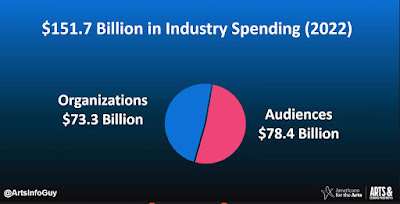by Patricia Frischer
The nature of this report is based on statistics and that means numbers. This is mainly because numbers are what governments understand. The stories that go with the numbers are actually art itself, the possible subjects of novels, plays, painting and poems, for example. The government is not “they”, it is people, and people can be affected by stories. So, we need the stories that go with the numbers just as badly as we need the numbers. The presentation by Randy Cohen (Americans for the Arts) of the AEP6 report tried to supply some of those stories.
Nationwide, in 2022 the nonprofit arts and culture industry generated $151.7 billion of economic activity. That is $73.3 billion (up from $63.8 billion in AEP5 in 2015) in spending by arts and cultural organizations and an additional $78.4b billion (way, way down from $102.5 billion in AEP5) in event-related expenditures by their audiences. Over all, the monies contributed to the economy fell from the $166.3 billion recorded in 2015. This is the story of the pandemic and its effect on the arts economy.
The good news is that personal creation in the arts grew by 37% with many people wanting to learn something new at home during COVID. Randy took up knitting! If that continues, art center workshops like those planned in the new Pacific View Art Center in Encinitas could grow in the next few years.
In
San Diego County, 7 municipalities and 2 cultural districts (City of San
Diego and Balboa Park Cultural District, Oceanside and Oceanside Cultural
District, Escondido, Carlsbad, Encinitas, National City, and Coronado) coordinated
efforts, representing over 60% of the county's population. This is the first
time so many cities joined in the study and that group plans to stay together
and hopefully expand.
AEP6 reveals that San Diego County’s nonprofit arts and culture sector is a
$1.3 billion industry (up from $1.1 billion in 2015)—one that supports 19,771
jobs (way down from 35,914 in 2015) and generates $320.7 million (less than
half of the $894.4 million in 2015) in local, state, and federal government
revenue. We notice lots of vacancies and calls for applicants in San Diego and
know that there will be a huge call for art teachers coming up with the passage
of CA Prop 28.

Another
heartening statistic was that BIPOC communities had similar percentages to non-BIPOC
for attendee spending, which means that a great job is being done to start to
support that community.
The study started 30 years ago and this year, 224,000 people interviewed by a total of 373 state/local partners nationwide. Some of these were as small as 4000 in the community. There were 16,399 non-profits arts organizations (not Broadway or Hollywood) who contributed data. Of course, we know that the non-profit orgs are often the start of a job that feeds that for profit work force. We are lucky in San Diego to have a two-way street with young talent starting here and older talent retiring here. That is one of the reasons why theater is so great and so well respected in our county.
Dr. Genna Styles-Lyas (top left) hosted the panel during the report presentation with lessons learned by her team charged with this project. So much of what she communicated is applicable in a much wider context. All arts organizations are different, one size does not fit all. Building relationship is the more important than just data gathering and no project is perfect. You can build out the tools but if you leave out strategies that could be repeated you are making more work for the team. Technical challenges will always be there especially with 25 languages and unconscious bias in the process that has to be acknowledged. The process of securing inclusivity constantly needs refining. Finally, the 297 representations who gathered the info made this report possible. The community will always be the basis for success and the community helped to gather the info, but then the local art partners learned about that community. It is a two-way street and one that needs time. AEP6 gave that time.
A number of celebrities were on hand to voice support for the arts.
 |
| Josh Groban |
 |
| Rita Moreno |
 |
| Fran Drescher |
The last thing that was presented was a call for action by Randy Cohen who will be making a presentation in San Diego in the new year.
 |
| Randy Cohen |
Advocate
for the arts to your local, state and national government. Tell no story
without a number, no number without a story. Investing in the arts is an
economic advantage for the entire community. The arts help with issues of
violence and mental health.
Attend
the arts and even try something new. Remember that the arts build empathy and
help you learn about other cultures. The arts can reduce feelings of isolation
and improve your general quality of life.










No comments:
Post a Comment